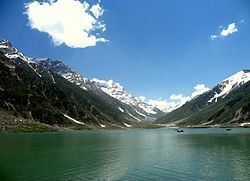Primary inflows Surface elevation 3,224 m | Primary outflows river ravi Surface area 2.75 km (1.06 sq mi) Area 2.75 km² | |
 | ||
Similar Ansoo Lake, Babusar Pass, Malika Parbat, Saiful Muluk National, Hindu Kush | ||
Beautiful lake view lake saiful muluk northern area pakistan
Saiful Muluk (Urdu: جھیل سیف الملوک) is a mountainous lake located at the northern end of the Kaghan Valley, near the town of Naran. It is in the north east of Mansehra District in the Khyber-Pakhtunkhwa province, Pakistan and feeds water to Kunhar river. At an elevation of 3,224 m (10,578 feet) above sea level, it is well above the tree line, and is one of the highest lakes in Pakistan.
Contents
- Beautiful lake view lake saiful muluk northern area pakistan
- Map of Saif ul Maluk Lake Pakistan
- Lake saiful muluk 3 nov 2010 naran kaghan valley pakistan by sony cyber shot hx5
- Location
- Physical features
- Ecology
- Folklore
- References
Map of Saif-ul-Maluk Lake, Pakistan
Lake saiful muluk 3 nov 2010 naran kaghan valley pakistan by sony cyber shot hx5
Location
Saiful Muluk is located in the Mansehra district of Khyber Pakhtunkhwa, about eight kilometers north of Naran, in the northern part of Kaghan valley. Malika Parbat, the highest peak in the valley is near the lake.
The lake is accessible from the nearby town of Naran during the summer season but access during winter is limited.
Physical features
Saiful Muluk was formed by glacial moraines that blocked the water of the stream passing through the valley. The Kaghan Valley was formed in the greater Pleistocene Period dating back almost 300,000 years when the area was covered with ice. Rising temperatures and receding glaciers left a large depression where glaciers once stood. Melting water collected into the lake.
Ecology
The lake has rich eco-diversity and holds many species of blue-green algae. Large brown trout are found in the lake, up to about seven kilograms. About 26 species of vascular plant exist in the area, with Asteraceae the most commonly found specie. Other species commonly found in the region are: Ranunculaceae, Compositae, Cruciferae, Gramineae, Apiaceae, Leguminosae, Scrophulariaceae and Polygonaceae.
Folklore
A fairy tale called Saif-ul-Muluk, written by the Sufi poet Mian Muhammad Bakhsh, talks of the lake. It tells the story of the prince of Persia named Shahzada Saif Ul Malook who fell in love with a fairy princess named Shehzadi Badri Jamala at the lake.
